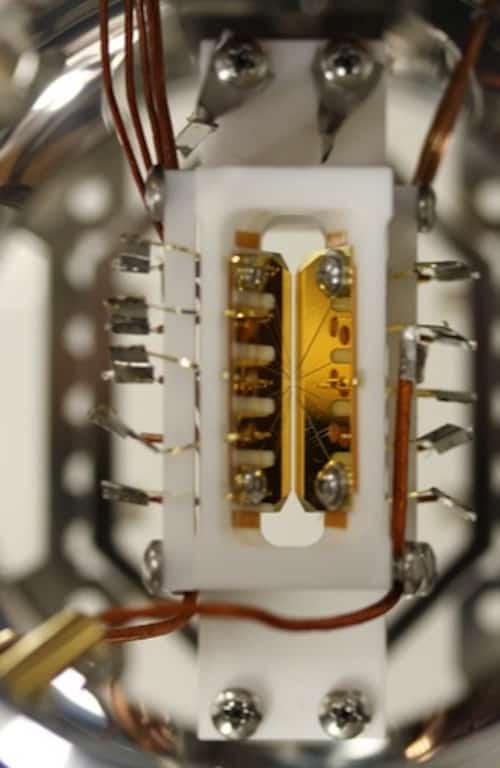A quantum circuit that can unambiguously test for information scrambling in an experiment could help verify the calculations of quantum computers and even shed more light on what happens to quantum information when it falls into a black hole. The new test, designed by researchers at the Joint Quantum Institute at the University of Maryland in the US, involves carefully manipulating the quantum behaviour of seven charged ions using well-timed sequences of laser pulses. It correctly determines whether information has been scrambled (as opposed to being completely lost) to an accuracy of around 80%.

Quantum information scrambling can be likened to shuffling a newly-bought deck of playing cards, which come ordered in a specific sequence, explain the researchers, led by Christopher Monroe and Norbert Linke. Although not something to try at home, because it would be tedious to say the least, the pack could be unshuffled by keeping a very careful track of how each shuffle exchanged the cards, and performing these shuffles in reverse.
In the same way, quantum scrambling mixes up the information stored inside a set of atoms and can also be reversed. This is the key difference between scrambled and true, irreversible, information loss, say the researchers.
In their work, Monroe, Linke and colleagues made use of a protocol first put forward by Beni Yoshida of the Perimeter Institute in Canada and Norman Yao at the University of California at Berkeley. Their approach distinguished between the two scenarios by teleporting the quantum states of particles through a quantum circuit and taking their correlations into account.
Unambiguous test for quantum scrambling
The new JQI approach consists of two steps. The researchers begin by scrambling up one set of qubits (in this case seven trapped 171Yb+ions in a crystal) in a fully connected quantum computer using a family of three-qubit scrambling “unitaries” and performing a related scrambling operation on a second set. Any mismatch between the two operations proves that the process is not scrambled, causing the second, and final step, to fail. This final step in fact relies on quantum teleportation, which is a way to transfer information between two quantum particles that are far apart (in this case 35 microns separate the first atom from the seventh). It serves as an unambiguous test for quantum scrambling, says the JQI team.
If information is successfully teleported from one atom to another across the quantum circuit, it means that the state of the first atom is correlated across all of the atoms, which can only happen if the information is scrambled. If the information is lost, successful teleportation is not possible.
Key to the success of the experiment comes from the fact that the researchers can finely control the qubits, which is no easy task. “We control the trapped-ion qubits by shining meticulously designed laser pulses that are resonant with the qubits to change their states individually,” explains study lead author Kevin Landsman. “We can use the same lasers to entangle qubits by leveraging the naturally occurring Coulomb repulsion between the positively charged ions.
“Measuring scrambling is very difficult and the measurements can easily by tainted by experimental error,” he tells Physics World. Previous tests for scrambling couldn’t distinguish between hidden and lost information, mainly because the individual atoms in both cases look very much the same.
Better understanding black holes
The measurements performed in this new work were, interestingly, inspired by the physics of black holes – and how information flows inside purely quantum-mechanical versions of these, which are believed to quickly scramble information. Researchers have previously suggested that any information falling into a black hole can be almost immediately recovered from its Hawking radiation (the light that is released by the black hole).

Ion-based commercial quantum computer is a first
Quantum scrambling is one way of explaining how information can fall into a black hole, scramble, and emerge as random radiation, say the JQI researchers. “The experiment we have set up mimics this theoretical scenario – and likens the input quantum state being teleported as the information falling into a black hole and the output as Hawking radiation.”
Since the three-qubit scrambler studied in this work is not strictly “many-body”, Landsman says that he and his colleagues would now like to build bigger and powerful quantum computers so that they can test for scrambling in these.
Full details of the present research are reported in Nature.



